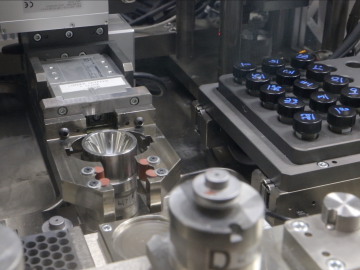
Filter News
Area of Research
- (-) Materials (44)
- (-) Nuclear Science and Technology (11)
- (-) Supercomputing (43)
- Advanced Manufacturing (2)
- Biology and Environment (18)
- Biology and Soft Matter (1)
- Computational Biology (1)
- Computational Engineering (1)
- Computer Science (7)
- Electricity and Smart Grid (2)
- Energy Science (81)
- Fusion and Fission (18)
- Fusion Energy (11)
- Isotopes (3)
- Materials for Computing (12)
- National Security (17)
- Neutron Science (18)
- Quantum information Science (7)
- Sensors and Controls (1)
- Transportation Systems (2)
News Type
News Topics
- (-) Chemical Sciences (11)
- (-) Coronavirus (10)
- (-) Fusion (12)
- (-) Grid (3)
- (-) Machine Learning (9)
- (-) Nanotechnology (17)
- (-) Quantum Science (15)
- (-) Space Exploration (7)
- (-) Transportation (14)
- 3-D Printing/Advanced Manufacturing (12)
- Advanced Reactors (10)
- Artificial Intelligence (23)
- Big Data (20)
- Bioenergy (6)
- Biology (7)
- Biomedical (15)
- Biotechnology (1)
- Buildings (4)
- Clean Water (3)
- Composites (6)
- Computer Science (64)
- Critical Materials (7)
- Cybersecurity (2)
- Energy Storage (15)
- Environment (24)
- Exascale Computing (17)
- Frontier (18)
- High-Performance Computing (28)
- Isotopes (11)
- Materials (33)
- Materials Science (39)
- Mathematics (2)
- Microscopy (13)
- Molten Salt (5)
- National Security (3)
- Neutron Science (20)
- Nuclear Energy (38)
- Partnerships (3)
- Physics (16)
- Polymers (11)
- Quantum Computing (16)
- Security (3)
- Simulation (13)
- Software (1)
- Summit (28)
Media Contacts

The type of vehicle that will carry people to the Red Planet is shaping up to be “like a two-story house you’re trying to land on another planet.

A modern, healthy transportation system is vital to the nation’s economic security and the American standard of living. The U.S. Department of Energy’s Oak Ridge National Laboratory (ORNL) is engaged in a broad portfolio of scientific research for improved mobility

Researchers at Oak Ridge National Laboratory proved that a certain class of ionic liquids, when mixed with commercially available oils, can make gears run more efficiently with less noise and better durability.

Using additive manufacturing, scientists experimenting with tungsten at Oak Ridge National Laboratory hope to unlock new potential of the high-performance heat-transferring material used to protect components from the plasma inside a fusion reactor. Fusion requires hydrogen isotopes to reach millions of degrees.

Using the Titan supercomputer at Oak Ridge National Laboratory, a team of astrophysicists created a set of galactic wind simulations of the highest resolution ever performed. The simulations will allow researchers to gather and interpret more accurate, detailed data that elucidates how galactic winds affect the formation and evolution of galaxies.

A new method developed at Oak Ridge National Laboratory improves the energy efficiency of a desalination process known as solar-thermal evaporation.

A team of researchers at Oak Ridge National Laboratory have demonstrated that designed synthetic polymers can serve as a high-performance binding material for next-generation lithium-ion batteries.

Scientists have tested a novel heat-shielding graphite foam, originally created at Oak Ridge National Laboratory, at Germany’s Wendelstein 7-X stellarator with promising results for use in plasma-facing components of fusion reactors.

Oak Ridge National Laboratory scientists have created open source software that scales up analysis of motor designs to run on the fastest computers available, including those accessible to outside users at the Oak Ridge Leadership Computing Facility.

By automating the production of neptunium oxide-aluminum pellets, Oak Ridge National Laboratory scientists have eliminated a key bottleneck when producing plutonium-238 used by NASA to fuel deep space exploration.


